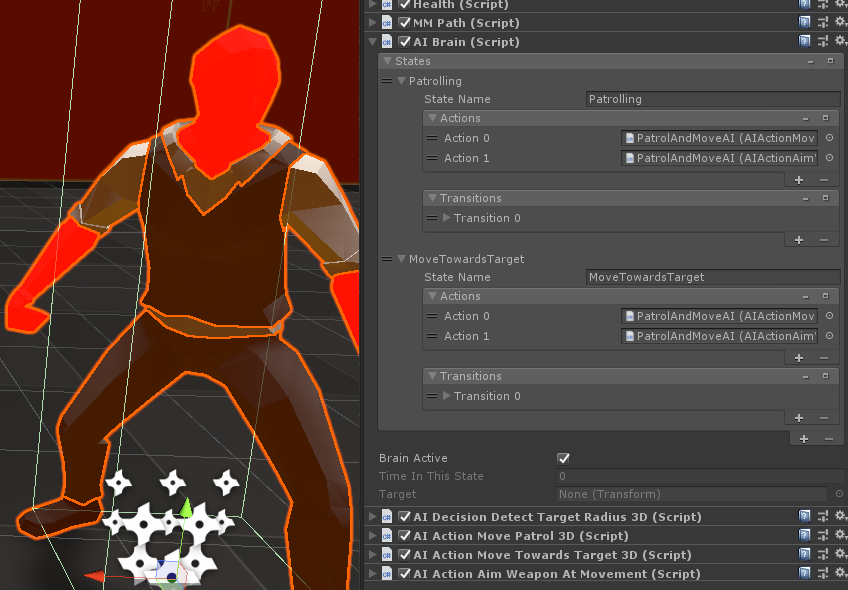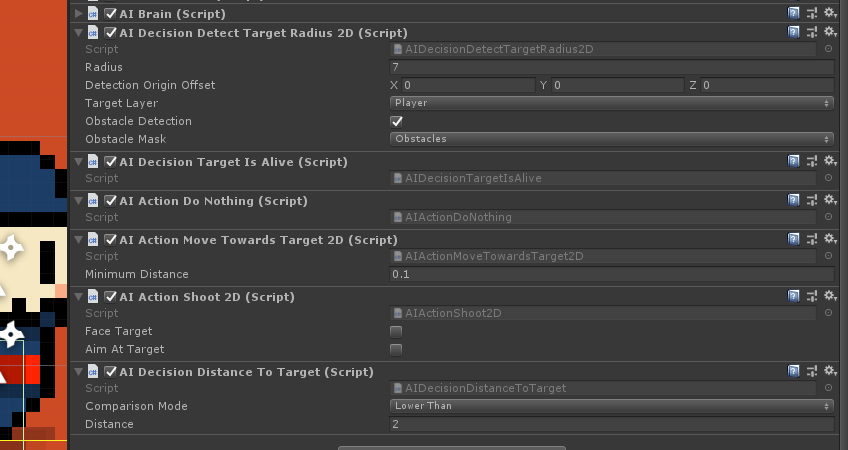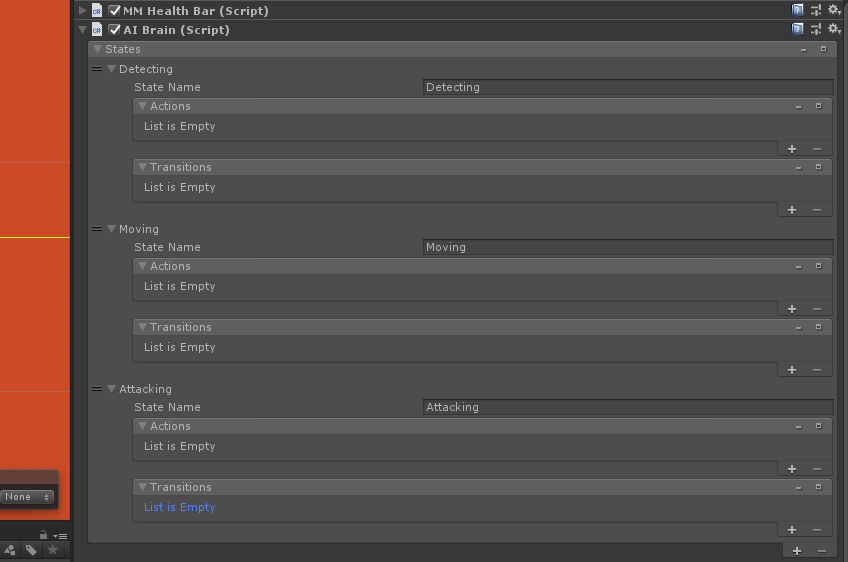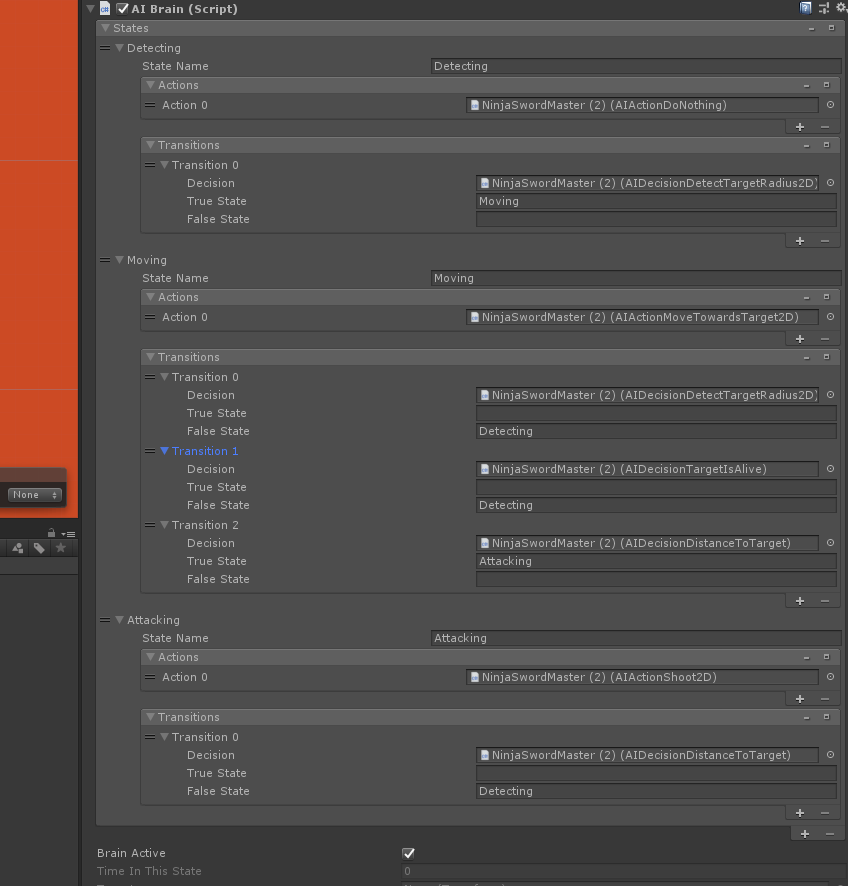Introduction
The TopDown Engine provides an advanced AI system that will help you create all sorts of interesting patterns and attitudes. For a brief overview of what you can do with it, you can have a look at the MinimalAI demo scene, which will showcase a tiny portion of the things you can create with this system.
Core concepts
The Advanced AI system is based on a few core classes you’ll find in the MMTools/AI/ folder:
- AIState: A State is a combination of one or more actions, and one or more transitions. An example of a state could be “patrolling until an enemy gets in range”.
- AIAction: Actions are behaviours and describe what your character is doing. Examples include patrolling, shooting, jumping, etc. The engine comes with a lot of predefined actions, and it’s very easy to create your own.
- AIDecision: Decisions are components that will be evaluated by transitions, every frame, and will return true or false. Examples include time spent in a state, distance to a target, or object detection within an area.
- AITransition: Transitions are a combination of one or more decisions and destination states whether or not these transitions are true or false. An example of a transition could be “if an enemy gets in range, transition to the Shooting state”.
- AIBrain: the AI brain is responsible from going from one state to the other based on the defined transitions. It’s basically just a collection of states, and it’s where you’ll link all the actions, decisions, states and transitions together.

All of these will be put on top of an already setup character (check out the dedicated doc for more on this) and can potentially leverage all existing abilities.
Creating an advanced AI character
We’ll recreate one of the example characters available in the KoalaDungeon demo scene, the NinjaSwordMaster. Creating the base character is no different from creating any character, so we won’t go over that again here. Once that base character is ready, you’ll want to add an AIBrain to it.
What we want from this character is the following behaviour: do nothing until an enemy gets close enough, and if that’s the case move towards it, and attack if close enough. Then if the target gets out of range, get back to doing nothing and waiting for a target.
To get there, we’ll use some of the ready made actions and decisions available in the engine. We’ll add the following components: AIDecisionDetectTargetRadius2D, AIDecisionTargetIsAlive, AIActionDoNothing, AIActionMoveTowardsTarget2D, AIActionShoot2D, AIDecisionDistanceToTarget. Each of these comes with an inspector where we’ll need to set a few things:
- AIDecisionDetectTargetRadius2D: we define our radius (7 in the example), our target layer should be Player, and we want to use the Obstacles layer as our Obstacle mask.
- AIDecisionTargetIsAlive: we’ll use that to make sure our target is still alive. No setup is required
- AIActionDoNothing: no setup required here
- AIActionMoveTowardsTarget2D: we’ll set the minimum distance to 0.1, that’s the distance to the target at which the character will consider its journey complete
- AIActionShoot2D: everything should be unchecked
- AIDecisionDistanceToTarget: we want to have this decision return true if the distance is lower than 2, so we set our comparison mode to “lower than”, and our distance to 2.

Our character now has all the actions and decisions we need to define its behaviour. All that’s left to do is plug all that into its brain. As stated before, our character will have 2 states: patrolling and attacking. So in its AIBrain component, we’ll simply add three states by pressing the bottom right “+” sign three times. We’ll name our first state “Detecting”, our second state “Moving”, and our third state “Attacking”.

Now in the Detecting state we’ll only have one action, and one transition, so we’ll add an Action and a Decision by pressing their respective “+” signs once each. We’ll now drag our character’s AIActionDoNothing component into the Actions’ array slot, and we’ll drag the AIDecisionDetectTargetRadius2D into the Transitions’ first Decision slot. Note that from v1.10 onwards, you can also select that action from a dropdown. We want to switch to moving when the player is in range, so we’ll put “Moving” in our transition’s True State field.
We’ll proceed in the same way for our second state: we’ll add an action and, this time, three transitions, then drag our AIActionMoveTowardsTarget2D component into our Moving state’s Action slot, and then move our AIDecisionDetectTargetRadius2D into the first transition’s detection slot, AIDecisionTargetIsAlive into the second transition’s slot, and finally AIDecisionDistanceToTarget in the 3rd transition’s slot. When the target is not in range anymore we want to go back to Detecting, so we’ll put Detecting in our first transition’s false state, and we also want to go back to detecting when the target is dead, so we’ll put Detecting in our second transition’s false state slot. And if the distance to target is low enough, we want to attack, so we’ll put Attacking in our 3rd transition’s true state slot.
In our last state, Attacking, we’ll add one action and one transition. Then we want to drag our AIActionShoot2D in the Action slot, and AIDecisionDistanceToTarget into the transition’s decision slot. If that distance is too high, we want to go back to Detecting, so we’ll put Detecting in the false state slot.

To make sure our brain is properly setup, we can just “read” it. From top to bottom, we have a character that is doing nothing, while waiting until a target gets within its radius. Then it starts to move, unless the target is dead or too far / out of sight. If, however, the target is close enough, it will attack, and go back to detecting if the target gets far enough.
Congratulations, you’ve completed what is probably the “hardest” thing to do with the TopDown Engine, and you now know how to create all sorts of character behaviours. You can of course have more than one action in a state (running and jumping for example) and more than one transition in a state, so you can really come up with complex stuff.
Actions
The engine comes with all of these predefined actions, ready to use in your own characters:
- AIActionAimObject: will let you aim an object’s axis (usually right or forward) at either the character’s movement direction or its aim direction.
- AIActionAimWeaponAtMovement: will force the weapon aim to the movement’s direction.
- AimWeaponAtTarget2D: will aim a weapon at the current Target in 2D
- AIActionChangeWeapon: used to force your character to switch to another weapon. Just drag a weapon prefab into its NewWeapon slot and you’re good to go.
- AIActionCrouchStart: makes your character crouch
- AIActionCrouchStop: makes your character stop crouching
- AIActionDash: causes the AI agent to dash using the Dash ability
- AIActionDoNothing: as the name implies, does nothing. Just waits there.
- AIActionMMFeedbacks: lets you play any MMFeedbacks you bind into its inspector
- AIActionFaceTowardsTarget2D: this AI action that lets you change the CharacterOrientation2D’s facing direction of an AI, and an example of it in action in the KoalaDungeon demo scene
- AIActionMoveAwayFromTarget2D/3D: makes the character move in the direction opposite to the target
- AIActionMovePatrol2D/3D: will have your character patrol through a set of nodes defined in an MMPath component. Make sure you set your MMPath’s cycle option to Loop or BackAndForth (you can’t patrol along a path in OnlyOnce mode, it has to be continuous).
- AIActionInvertPatrolDirection: lets you invert the direction of a target 2D or 3D patrol
- AIActionMoveRandomly2D/3D: makes the character move randomly, until it finds an obstacle in its path, in which case it’ll pick a new direction at random
- AIActionMoveRandomlyGrid: moves randomly on a grid, whether a 2D or a 3D one
- AIActionMoveTowardsTarget2D/3D: directs the CharacterHorizontalMovement ability to move in the direction of the target.
- AIActionPathfinderToPatrol3D: will use the Pathfinding3D ability to move back to its last patrol point
- AIActionPathfinderToTarget3D: will use the Pathfinding3D ability to move to the target if a path can be found
- AIActionReload: causes the agent to reload its current weapon
- AIActionResetTarget: lets you reset the current Brain target, setting it to null
- AIActionRotateConeOfVision2D: will rotate this AI’s ConeOfVision2D either towards the AI’s movement or its weapon aim direction
- AIActionRotateTowardsTarget2D/3D: will make the CharacterOrientation3D ability rotate the character towards the Brain’s target
- AIActionRunStart: will cause the agent to start running (requires a CharacterRun ability)
- AIActionRunStop: will cause the agent to stop running (requires a CharacterRun ability)
- AIActionSelfDestruct: will kill this AI
- AIActionSetLastKnownPositionAsTarget: will set the last known position of the target as the new Target
- AIActionSetPlayerAsTarget: will set the current Player (as known by the Level Manager) as the current Target
- AIActionShoot2D/3D: causes the currently equipped weapon to be used (regardless of whether it’s a melee/projectile/hitscan/etc weapon). If your weapon is in auto mode, will shoot until you exit the state, and will only shoot once in SemiAuto mode (in that case, you’ll want to cycle in and out of your attack state, see example on the NinjaSwordMaster prefab). Do not use WeaponAutoShoot on AI characters, that’s a player character class only. You can optionnally have the character face (left/right) the target, and aim at it (if the weapon has a WeaponAim component), or pick various points of origin to define how aim direction will be computed.
- AIActionSwapBrain: lets you brain a Character’s current Brain for another one. Useful for things like boss phases, for example
- AIActionUnityEvents: lets you trigger any Unity event you bind into its inspector
Just like everything else in the engine, you’re encouraged to create your own. Let’s look at an Action’s code to see how it works:
public class AIActionJump : AIAction
{
public int NumberOfJumps = 1;
protected CharacterJump _characterJump;
protected int _numberOfJumps = 0;
protected override void Initialization()
{
_characterJump = this.gameObject.GetComponent<CharacterJump>();
}
public override void PerformAction()
{
Jump();
}
protected virtual void Jump()
{
if (_numberOfJumps < NumberOfJumps)
{
_characterJump.JumpStart();
_numberOfJumps++;
}
}
public override void OnEnterState()
{
base.OnEnterState();
_numberOfJumps = 0;
}
}
As you can see this class overrides a few methods:
- Initialization, in which we’ll do whatever we need to do to initialize our Action, in this case we store the CharacterJump ability for future use.
- PerformAction: this will be called everytime our character is in the state this Action is in. In this case we’ll just call our Jump method, that in turns calls the CharacterJump ability’s JumpStart method if our conditions are met.
- OnEnterState: everytime we’ll go back to the state that contains this Action, we’ll want to reset our current number of jumps.
Decisions
- AIDecisionDetectTargetConeOfVision2D/3D: uses a field of view to determine whether or not a target is in view. Returns true if that’s the case.
- AIDecisionDetectTargetLine2D: will return true if any object on its TargetLayer layermask enters its line of sight. It will also set the Brain’s Target to that object. You can choose to have it in ray mode, in which case its line of sight will be an actual line (a raycast), or have it be wider (in which case it’ll use a spherecast). You can also specify an offset for the ray’s origin, and an obstacle layer mask that will block it.
- AIDecisionConditionState: this decision will return true if the character is in the specified condition state
- AIDecisionDetectTargetLine3D: lets you detect targets using raycasts or boxcasts in line in a 3D context
- AIDecisionTargetRadius2D/3D: will return true if an object on its TargetLayer layermask is within its specified radius, false otherwise. It will also set the Brain’s Target to that object.
- AIDecisionPathToTargetExists: will return true if a complete path can be found to pathfind to the current brain target
- AIDecisionDistanceToTarget: will return true if the current Brain’s Target is within the specified range, false otherwise.
- AIDecisionGrounded: will return true if the character is grounded, false otherwise.
- AIDecisionHealth: will return true if the specified Health conditions are met. You can have it be lower, strictly lower, equal, higher or strictly higher than the specified value.
- AIDecisionHit: returns true if the Character got hit this frame, or after the specified number of hits has been reached.
- AIDecisionLineOfSightToTarget2D/3D: will return true if a line can be traced to the target from the specified offset and not hitting the specified layers
- AIDecisionMMPathEndReached: will return true if the end of the MMPath has been reached, false otherwise
- AIDecisionNextFrame: will return true when entering the state this Decision is on.
- AIDecisionRandom: will roll a dice and return true if the result is below or equal the odds value specified in its inspector
- AIDecisionReloadNeeded: returns true if a reload is needed at the frame it’s evaluated at
- AIDecisionTargetFacingAI2D: will return true if the Brain’s current target is facing this character. Yes, it’s quite specific to Ghosts. But hey now you can use it too!
- AIDecisionTargetIsAlive: will return true if the target is alive
- AIDecisionTargetIsNull: will return true if the target is null
- AIDecisionTimeInState: will return true after the specified duration (in seconds) has passed since the Brain has been in the state this decision is in. Use it to do something X seconds after having done something else.
- AIDecisionTimeSinceStart: will return true after the specified duration (in seconds) has passed since the level was loaded.
And just like Actions, it’s very easy to create your own Decisions.
Organizing AI components
When building complex characters, your Character’s inspector list of components can get pretty massive, between the agent’s core classes (Character, TopDownController, etc), the abilities, and the brain, actions and decisions. Fortunately, v1.10 introduced the ability to split these abilities across multiple nodes, and that’s also true for the brain, actions and decisions.
You can see an example of a Character setup that way in the Loft3D demo scene, with the PatrolSeekAndDestroyAI prefab. At its top level, you’ll find its core classes. Then, on empty game objects nested under it, you’ll find a node with its abilities (Abilities), and one with its brain (AIBrain). To push things further, if needed, the actions and decisions can also be split across more nodes. The only important thing about this setup is to make sure you’ve bound your Brain to the Character’s inspector, in its CharacterBrain field. If you don’t, it’ll automatically look for one at its own level. And for abilities, you can learn more about it in the dedicated section of the documentation.
Pathfinding
The engine lets you use pathfinding natively in 3D, using various actions listed above. For this, you’ll need to have a correctly setup navmesh. To learn more about Unity’s Navmesh system, you can check its documentation here. As for 2D, there’s still no native solution for that in Unity. Most people use A*, and you’ll find examples of integration in the extensions repository.
AI Recipes
Here you’ll find a number of step by step recipes for a number of various AI setups:
Creating a simple AI that will follow and rotate towards the player
- in Unity 6000.0.23f1 (or higher), create a new project and import TopDown Engine v4.4 via the Package Manager
- open the MinimalScene3D
- create an empty game object, name it “MyChar”, position it at 0,0,0
- create a cube, position it at 0,0,0, nest it under MyChar, name it MyModel
- via the AddComponent dropdown in its inspector, add a Character component to MyChar, press AutoBuild AI Character 3D
- in CharacterOrientation3D, drag MyModel to the MovementRotatingModel slot, set rotation mode to MovementDirection
- add an AI brain, AIDecisionDetectTargetRadius3D, AIActionMoveTowardsTarget3D, AIActionRotateTowardsTarget3D
- in the brain, add a new state, name it Detect, add a transition to it, set the decision to DetectTargetRadius, TrueState to Move
- add a new state, name it Move, no Transition, set its Actions to Move and Rotate towards target
- in the Detect target radius set the TargetLayerMask to Player
- press play, move around, AI follows and rotates towards target
Creating a simple, turret-like, rotating AI
- in Unity 6000.0.23f1 (or higher), create a new project and import TopDown Engine v4.4 via the Package Manager
- import TDE v1.10.1 (check version in the readme)
- open the MinimalScene3D
- create a new empty game object, name it Test
- under it, create a new cube, name it Model
- on the Test node, add a Character component, press its Autobuild AI Character 3D button, drag the Model node into the Character’s CharacterModel slot
- on the CharacterOrientation3D uncheck ShouldRotateToFaceWeaponDirection, check ForcedRotation, bind the Model into the MovementRotatingModel slot, set RotationMode to MovementDirection,
- on the Test node, add AIBrain, AIActionDoNothing, AIDecisionDetectTargetRadius3D and AIActionRotateTowardsTarget3D components
- on the AIDecisionDetectTargetRadius3D comp, set the TargetLayerMask to Player
- on the AIActionRotateTowardsTarget3D, check LockRotationX
- on the AIBrain, create a new state, call it Wait, set AIActionDoNothing as its action, AIDecisionDetectTargetRadius3D as its transition’s decision, TrueState:Rotate
- create a second state, call it Rotate, set its Action as AIActionRotateTowardsTarget3D
- press play, enjoy your tiny AI!
Creating a turret-like enemy AI that shoots at the player
- in Unity 6000.0.23f1 (or higher), create a new project and import TopDown Engine v4.4 via the Package Manager
- open the MinimalScene3D demo scene
- create a new, empty game object, position it at 0,0,0, call it Test
- create a new cube, drag it under Test, position it at 0,0,0, name it Model, remove its BoxCollider
- on Test, add a Character component, press AutoBuild AI Character 3D
- on the Character component, drag the Model into the CharacterModel slot
- under CharacterOrientation3D, set Rotation Mode to Weapon Direction, drag the Model into the Movement Rotating Model slot
- add a CharacterHandleWeapon ability, set the LoftAIAssaultRifle as its InitialWeapon
- add an AIBrain, AIActionDoNothing, AIDecisionDetectTargetRadius3D (TargetLayerMask:Player), AIActionShoot3D, AIActionRotateTowardsTarget3D
- on the AIBrain, create two states : Detect (DoNothing and DetectRadius, TrueState:Shoot) and Shoot (Actions: Rotate and shoot)
- of course that AI will never stop shooting once it’s detected the player, but from there you can modify its brain to have it do more things if you’d like
Setting up 2D cones of vision powered AIs
- in Unity 6000.0.23f1 (or higher), create a new project and import TopDown Engine v4.4 via the Package Manager
- open KoalaDungeon
- select the first ninja to the left, right click, unpack it completely
- rename it to NinjaWithCone (or whatever), and make a prefab of it
- open the Koala prefab, select its ConeOfVision node, copy it
- open the NinjaWithCone prefab, paste the ConeOfVision into it, put it at the same level as the NinjaModel or the Feedbacks (under the top level), position it at 0,0,0
- at the top level of that prefab, remove AIDecisionTargetRadius2D
- add a MMConeOfVision2D, set ObstacleMask to Obstacles, TargetMask to Player, and drag the ConeOfVision into the VisionMeshFilter slot at the bottom
- add a AIDecisionDetectTargetConeOfVision2D, and in the AIBrain, change the first State’s transition’s decision to AIDecisionDetectTargetConeOfVision2D
- press play, walk into the Ninja’s cone, notice it acquires the Player as the target and starts attacking it
Bonus steps if you want the cone to move too :
- add an AIActionRotateConeOfVision2D
- add an AIActionMoveRandomly2D
- in the AIBrain’s first state, replace the action (AIActionDoNothing) with AIActionMoveRandomly2D, and add a second action, and make it AIActionRotateConeOfVision2D
Of course it’d be impossible to cover the virtually infinite amount of combinations for so many actions and decisions. But you’ll find a ton more examples in the engine’s demos. Here are some of the most common archetypes you may find interesting:
- KoalaNinjaRifle: 2D character using a projectile weapon
- KoalaNinjaSwordMaster: 2D character using a melee weapon
- LoftPatrolAndShootAI: 3D character using a projectile weapon
- LoftPatrolConeSeekAndDestroyAI: 3D character using vision angle
- LoftPatrolAndPathfinderAI 3D pathfinding agent
- KoalaPoolableNinja: poolable/reusable AI agent
- KoalaNinjaPatrol: simple 2D patrol agent